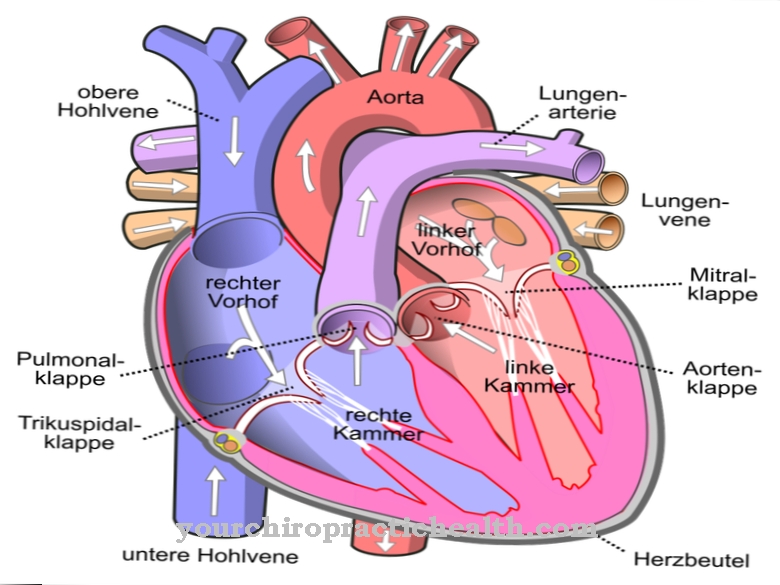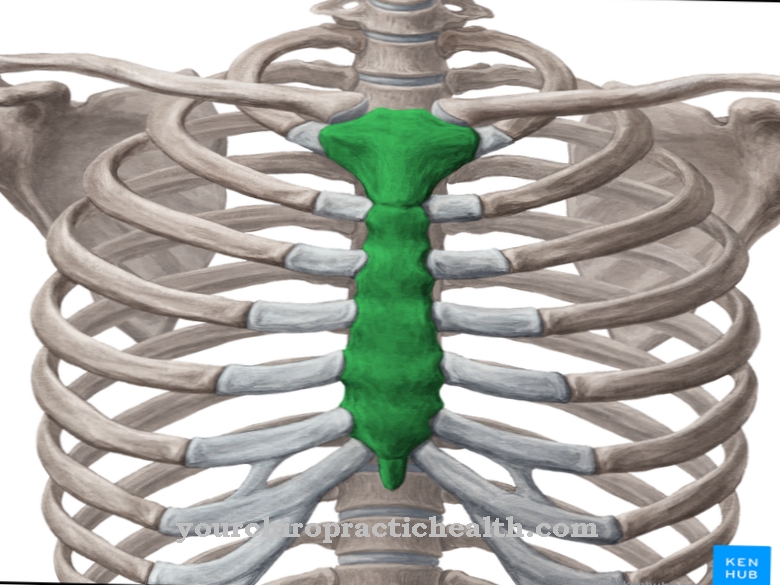Of the Sternothyroid muscle is a muscle of the human skeletal system. It is located between the tongue and the larynx. Its task is to support the swallowing process.
What is the sternothyroid muscle?
The sternothyroid muscle is called the Sternal thyroid cartilage muscle designated. It is a muscle that belongs to the muscles of the hyoid bone. This is known as the infrahyric muscles.
The sternothyroid muscle is a narrow muscle that extends from the sternum to the top of the larynx. He is significantly involved in the implementation of the act of swallowing. As soon as the sternothyroid muscle fibers contract, the hyoid bone moves downward. At the same time, the larynx is also moved downwards. This process takes place at the moment when the swallowing reflex begins. This clears the way to the stomach. This process is no longer subject to voluntary control, even if the preparations for the act of swallowing are controlled and planned.
Anatomy & structure
The sternothyroid muscle is a striated muscle. This means that the muscle fibers of the muscle have an arrangement in which they repeat themselves periodically.
This gives a certain pattern. It is created by horizontal stripes. The sternothyroideus muscle arises from the manubrium sterni. This is part of the sternum. It is located cranially, i.e. at the top, and forms the widest part of the sternum. This is called the sternum in medicine. The breastbone connects to the collarbone. The larynx is called the larynx. It consists of fibers and cartilage and is set in motion by various muscles. The larynx has a vertical shape and is surrounded by various layers of cartilage.
They include the thyroid cartilage, the cricoid cartilage, the actuating cartilage and the epiglottis cartilage. The thyroid cartilage is called the cartilago thyreoidea. The sternothyroideus muscle runs from the sternum below the sternohyoideus muscle. Its path goes to the thyroid cartilage, which it sets in motion. The sternothyroid muscle is innervated by the ansa cervicalis. This is a nerve pathway made up of various fibers from the neck plexus and the spinal cord.
Function & tasks
The sternothyroid muscle, together with other muscles in the mouth and throat area, is responsible for the functional activity of swallowing. During the act of swallowing, the throat first rises and then it falls. At the same time, the windpipe is closed so that the fluids, food and saliva produced in the mouth can be conducted directly into the esophagus and down to the stomach.
The act of swallowing is considered to be very complex. Different muscles work closely together so that this can run smoothly. The process of swallowing is divided into a deliberately controlled and an automatic sequence. Preparations, such as chopping up food or adding liquids, are part of the voluntarily controlled process. You initiate the act of swallowing. The absorbed substances are moved deep into the throat. The functionality of the tongue plays an important role here. Once there, the swallowing reflex is initiated automatically.
During this process the windpipe is closed and the base of the tongue is raised. This pushes food, saliva and fluids deeper into the throat. The hyoid bone lowers so that they can then also flow away. At the same time, the larynx also lowers. The activity of the sternothyroid muscle causes the hyoid bone and the upper cartilage of the larynx to lower. In doing so, it makes a significant contribution to a well-functioning act of swallowing.
You can find your medication here
➔ Medicines for hoarsenessDiseases
The diseases that have an influence on the activity of the sternothyroid muscle include all those whose symptoms include symptoms in the mouth or larynx. These can be inflammatory diseases, paralysis, swellings, new tissue formation and infections.
In the case of inflammation and infection, problems arise with the act of swallowing. The swallowing process can no longer be carried out in the event of paralysis or cramp. The swelling includes enlargement of the tonsils or lymph. They close the entrance to the neck and narrow the esophagus. Sleep disorders such as sleep apnea cause breathing to stop. The muscles relax spontaneously while the human consciousness is not active. Neoplasms, such as edema or cysts in the entrance of the neck to the larynx, contribute to a narrowing of the canal between the throat and the upper larynx area.
The formation of a carcinoma significantly affects the functioning of the larynx. Accidents or falls in which the throat is affected have an immense influence on the swallowing process and phonotonia. Since the larynx is surrounded by a cartilage framework, it does not have the necessary protection as soon as the neck is narrowed from the outside. A narrowing of the throat does not only affect the act of swallowing. In addition, the air supply is restricted or exposed.
In the event of an emergency or the rescue of a person, emergency oxygen supply can in some cases be provided. For this procedure, a tracheal incision is made and intubated. Depending on the situation, this can lead to damage to the cartilage on the larynx. In medicine, this is referred to as trauma. Trauma can also occur when a patient has to be intubated for a long period of time. In addition, anything that attacks the throat and pharynx is harmful. This includes smoking as well as inhaling toxic gases.
























.jpg)



